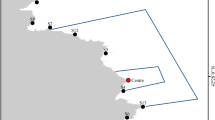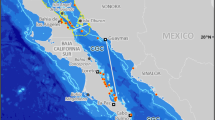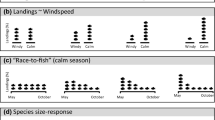Abstract
Reserves are being used increasingly to conserve fish communities and populations under threat from overfishing, but little consideration has been given to how fish behavior might affect reserve function. This review examines the implications of how fish use space, in particular the occurrence and size of home ranges and the frequency and direction of home range relocations. Examples are drawn primarily from the literature on coral reef fishes, but the principles apply to other habitats. Reserves can protect fish species only if individuals restrict their movements to a localized home range during at least part of the life cycle. Home range sizes increase with body size. In small reserves, a significant proportion of fish whose home ranges are centered within the reserve can be exposed to fishing mortality because their home ranges include non-reserve areas. Relocation of home ranges following initial settlement increases exposure to the fishery, especially if habitat selection is frequency-dependent. Distance, barriers, and costs of movement counter such redistribution. These considerations lead to predictions that population density and mean fish size (1) will form gradients across reserve boundaries with maxima in the center of the reserve and minima outside the reserve away from the boundary; (2) will increase rapidly in newly established reserves, only later providing ‘spillover’ to adjacent fisheries as density-dependent emigration begins to take effect; and (3) will be higher in reserves that are larger and have higher area:edge ratios, more habitat types, natural barriers between reserve and non-reserve areas, and higher habitat quality inside than outside the reserve. (4) Species with low mobility and weak density-dependence of space use will show the greatest increase in reserves and the strongest benefit for population reproductive capacity, but those with intermediate levels of these traits will provide the greatest spillover benefit to nearby fisheries.
Similar content being viewed by others

References cited
Alcala, A.C. & G.R. Russ. 1990. A direct test of the effects of protective management on abundance and yield of tropical marine resources. J. Cons. Int. Explor. Mer. 46: 40-47.
Anderson, D.J. 1982. The home range: a new nonparametric estimation technique. Ecology 63: 103-112.
Ballantine, W.J. 1995. Networks of ‘no-take’ marine reserves are practical and necessary. pp. 13-20. In:N.L. Shackell & J.H.M. Willison (ed.) Marine Protected Areas and Sustainable Fisheries, Science and Management of Protected Areas Association, Wolfville.
Barrows, E.M. 1996. Animal behavior desk reference, second printing. C.R.C. Press, Boca Raton. 672 pp.
Beets, J. & A. Friedlander. 1999. Evaluation of a conservation strategy: a spawning aggregation closure for red hind, Epinephelus guttatus, in the U.S. Virgin Islands. Env. Biol. Fish. 55: 91-98 (this issue).
Bohnsack, J.A. & J.S. Ault. 1996. Management strategies to conserve marine biodiversity. Oceanography 9: 73-82.
Bohnsack, J.A., D.E. Harper, D.B. McClellan & M. Hulsbeck. 1994. Effects of reef size on colonization and assemblage structure of fishes at artificial reefs off southeastern Florida, U.S.A. Bull. Mar. Sci. 55: 796-823.
Brett, J.R. 1965. The relation of size to rate of oxygen consumption and sustained swimming speed of sockeye salmon (Oncorhynchus nerka). J. Fish. Res. Board Can. 22: 1491-1501.
Brock, R.E., C. Lewis & R.C. Wass. 1979. Stability and structure of a fish community on a coral patch reef in Hawaii. Mar. Biol. 54: 281-292.
Buechner, M. 1987. Conservation in insular parks: simulation models of factors affecting the movement of animals across park boundaries. Biol. Cons. 41: 57-76.
Burke, N.C. 1995. Nocturnal foraging habitats of French and bluestriped grunts, Haemulon flavolineatumand H. sciurus, at Tobacco Caye, Belize. Env. Biol. Fish. 42: 265-374.
Caley, M.J., M.H. Carr, M.A. Hixon, T.P. Hughes, G.P. Jones & B.A. Menge. 1996. Recruitment and the local dynamics of open marine populations. Annu. Rev. Ecol. Syst. 27: 477-500.
Caro, T.M. 1998. Behavioral ecology and conservation biology, Oxford University Press, Oxford. 480 pp.
Caro, T.M. & S.M. Durant. 1995. The importance of behavioural ecology for conservation biology: examples from Serengeti carnivores. pp. 451-472. In:A.R.E. Sinclair & P. Arcese (ed.) Serengeti II: Research, Management and Conservation of an Ecosystem, University of Chicago Press, Chicago.
Chapman, M.R. 1997. Coral reef fish movements and the effectiveness of the Barbados Marine Reserve. M.Sc. Thesis, McGill University, Montréal. 67 pp.
Chapman, M.R. & D.L. Kramer. 1999a. Movement of post-settlement fishes within and among fringing coral reefs in Barbados. Env. Biol. Fish. (in press).
Chapman, M.R. & D.L. Kramer. 1999b. Gradients in coral reef fish density and size across the Barbados Marine Reserve boundary: effects of reserve protection and habitat characteristics. Mar. Ecol. Prog. Ser. (in press).
Clemmons, J.R. & R. Buchholz (ed.) 1997. Behavioral approaches to conservation in the wild. Cambridge University Press, New York. 400 pp.
Colin, P.L., D.Y. Shapiro & D. Weiler. 1987. Aspects of the reproduction of two groupers, Epinephelus guttatusand E. striatusin the West Indies. Bull. Mar. Sci. 40: 220-230.
Colton, D.E. & W.S. Alevizon. 1983. Movement patterns of bonefish, Albula vulpes, in Bahamian waters. U.S. Fish. Bull. 81: 148-154.
Cook, M.F. & E.P. Bergerson. 1988. Movements, habitat selection, and activity periods of northern pike in Eleven Mile Reservoir, Colorado. Trans. Amer. Fish. Soc. 117: 495-502.
DeMartini, E.E. 1993. Modeling the potential of fishery reserves for managing Pacific coral reef fishes. U.S. Fish. Bull. 91: 414-427.
Diana, J.S., W.C. Mackay & M. Ehrman. 1977. Movements and habitat preference of northern pike (Esox luciu) in Lac St. Anne, Alberta. Trans. Amer. Fish. Soc. 106: 560-565.
Diana, J.S., D.F. Clapp, E.M. Hay-Chmielewski, G. Schnicke, D. Siler, W. Ziegler & R.D. Clark, Jr. 1989. Relative success of telemetry studies in Michigan. Amer. Fish. Soc. Symp. 7: 346-352.
Dubin, R.E. & J.D. Baker. 1982. Two types of cover-seeking behaviour at sunset by the princess parrotfish, Scarus taeniopterus, at Barbados, West Indies. Bull. Mar. Sci. 32: 572-583.
Dugan, J.E. & G.E. Davis. 1993. Applications of marine refugia to coastal fisheries management. Can. J. Fish. Aquat. Sci. 50: 2029-2042.
Fish, P.A. & J. Savitz. 1983. Variations in ranges of largemouth bass, yellow perch, bluegills, and pumpkinseeds in an Illinois Lake. Trans. Amer. Fish. Soc. 112: 147-153.
Frederick, J.L. 1997. Post-settlement movement of coral reef fishes and bias in survival estimates. Mar. Ecol. Prog. Ser. 150: 65-74.
Fretwell, S.D. 1972. Populations in a seasonal environment. Princeton University Press, Princeton. 217 pp.
Fricke, H.W. 1980. Mating systems, maternal and biparental care in triggerfish (Balistidae). Z. Tierpsychol. 53: 105-122.
Furlow, F.B. & T. Armijo-Prewitt. 1995. Peripheral populations and range collapse. Cons. Biol. 9: 1345.
Gerking, S.D. 1959. The restricted movement of fish populations. Biol. Rev. 34: 221-242.
Gibson, R.N. 1993. Intertidal teleosts: life in a fluctuating environment. pp. 513-536. In:T.J. Pitcher (ed.) The Behaviour of Teleost Fishes, Second Edition, Chapman & Hall, London.
Grant, J.W.A. 1997. Territoriality. pp. 81-103. In:J.-G.J. Godin (ed.) Behavioural Ecology of Teleost Fishes, Oxford University Press, Oxford.
Grant, J.W.A. & D.L. Kramer 1990. Territory size as a predictor of the upper limit to population density of juvenile salmonids in streams. Can. J. Fish. Aquat. Sci. 47: 1724-1737.
Hixon, M.A. 1981. An experimental analysis of territoriality in the California reef fish Embiotoca jacksoni(Embiotocidae). Copeia 1981: 653-665.
Hixon, M.A. 1987. Territory area as a determinant of mating systems. Amer. Zool. 27: 229-247.
Hixon, M.A. 1998. Population dynamics of coral-reef fishes: controversial concepts and hypotheses. Aust. J. Zool. (in press).
Hixon, M.A. & J.P. Beets. 1993. Predation, prey refuges, and the structure of coral-reef fish assemblages. Ecol. Monogr. 63: 77-101.
Hixon, M.A. & M.H. Carr. 1997. Synergistic predation, density dependence, and population regulation in marine fish. Science 277: 946-949.
Hockey, P.A.R. & G.M. Branch. 1994. Conserving marine biodiversity on the African coast: implications of a terrestrial perspective. Aquat. Cons. Mar. Freshw. Ecosyst. 4: 345-362.
Hoffmann, S.G. 1983. Sex-related foraging behaviour in sequentially hermaphroditic hogfishes. Ecology 64: 798-808.
Holland, K., J.D. Peterson, C.G. Lowe & B.M. Wetherbee. 1993. Movements, distribution and growth rates of the white goatfish Mulloides flavolineatusin a fisheries conservation zone. Bull. Mar. Sci. 52: 982-992.
Holland, K., C.G. Lowe & B.M. Wetherbee. 1996. Movements and dispersal patterns of blue trevally (Caranx melampygus) in a fisheries conservation zone. Fish. Res. 25: 279-292.
Johannes, R.E. 1981. Words of the lagoon. University of California Press, Berkeley. 245 pp.
Jones, G.P. 1991. Postrecruitment processes in the ecology of coral reef fish populations: a multifactorial perspective. pp. 294-328. In:P.F. Sale (ed.) The Ecology of Fishes on Coral Reefs, Academic Press, San Diego.
Kramer, D.L., R.W. Rangeley & L.J. Chapman. 1997. Habitat selection: patterns of spatial distribution from behavioural decisions. pp. 37-80. In:J.-G.J. Godin (ed.) Behavioural Ecology of Teleost Fishes, Oxford University Press, Oxford.
Lawson, G.L., D.L. Kramer & W. Hunte. 1999. Size-related habitat use and schooling behavior in two species of surgeonfish (Acanthurus Bahianusand A. coeruleus) on a fringing reef in Babados, West Indies. Env. Biol. Fish. 54: 19-33.
Leis, J.M. 1991. The pelagic stage of reef fishes: the larval biology of coral reef fishes. pp. 183-230. In:P.F. Sale (ed.) The Ecology of Fishes on Coral Reefs, Academic Press, San Diego.
Lesica, P. & F.W. Allendorf. 1995. When are peripheral populations valuable for conservation? Cons. Biol. 9: 753-760.
Lewis, A.R. 1997. Recruitment and post-recruitment immigration affect the local population size of coral reef fishes. Coral Reefs 16: 139-149.
Linfield, R.S.J. 1985. An alternative concept to home range theory with respect to populations of cyprinids in major river systems. J. Fish Biol. 27(Supp. A): 187-196.
Lirman, D. 1994. Ontogenetic shifts in habitat preference in the three-spot damselfish, Stegastes planifrons(Cuvier), in Roatan Island, Honduras. J. Exp. Mar. Biol. Ecol. 180: 71-81.
Low, R.M. 1971. Interspecific territoriality in a pomacentrid reef fish, Pomacentrus flavicaudaWhitley. Ecology 52: 649-654.
Luckhurst, B.E. & K. Luckhurst. 1978. Diurnal space utilization in coral reef fish communities. Mar. Biol. (Berl.) 49: 325-332.
MacCall, A.D. 1990. Dynamic geography of marine fish populations. University of Washington Press, Seattle. 153 pp.
Matheney, M.P. IV & C.F. Rabeni. 1995. Patterns of movement and habitat use by northern hog suckers in an Ozark stream. Trans. Amer. Fish. Soc. 124: 886-897.
Mathews, S.B. & M.W. Barker. 1983. Movements of rockfish (Sebastes) in Northern Puget Sound, Washington. U.S. Fish. Bull. 82: 916-922.
Matthews, K.R. 1990. An experimental study of habitat preferences and movement patterns of copper, quillback, and brown rockfishes (Sebastesspp.). Env. Biol. Fish. 29: 161-178.
Matthews, K.R. 1996. Diel movement and habitat use of California golden trout in the Golden Trout Wilderness, California. Trans. Amer. Fish. Soc. 125: 78-86.
McAfee, S.T. & S.G. Morgan. 1996. Resource use by five sympatric parrotfishes in the San Blas Archipelago, Panama. Mar. Biol. 125: 427-437.
McClanahan, T.R. & N.A. Muthiga. 1988. Changes in Kenyan coral reef community structure and function due to exploitation. Hydrobiologia 166: 269-276.
McLaughlin, R.L. & D.L. Kramer. 1991. The association between amount of red muscle and mobility in fishes: a statistical evaluation. Env. Biol. Fish. 30: 369-378.
Norman, M.D. & G.P. Jones. 1984. Determinants of territory size in the pomacentrid reef fish, Parma victoriae. Oecologia 61: 60-69.
Nursall, J.R. 1977. Territoriality in redlip blennies (Ophioblennicus atlanticus—-Pisces: Blenniidae). J. Zool., Lond. 182: 205-223.
Ogden, J.C. & N.S. Buckman. 1973. Movements, foraging groups, and diurnal migrations of the striped parrotfish Scarus croicensisBloch (Scaridae). Ecology 54: 589-596.
Ogden, J.C. & P.R. Ehrlich. 1977. The behavior of heterotypic resting schools of juvenile grunts (Pomadasyidae). Mar. Biol. (Berl.) 42: 273-280.
Polacheck, T. 1990. Year around closed areas as a management tool. Nat. Res. Model. 4: 327-354.
Polunin, N.V.C. 1990. Marine regulated areas: an expanded approach for the tropics. Resource Management and Optimization 7: 283-299.
Polunin, N.V.C. & C.M. Roberts. 1996. Reef fisheries. Chapman & Hall, London. 477 pp.
Power, M.E. 1984. Habitat quality and the distribution of algae-grazing catfish in a Panamanian stream. J. Anim. Ecol. 53: 357-374.
Rakitin, A. & D.L. Kramer. 1996. Effect of a marine reserve on the distribution of coral reef fishes in Barbados. Mar. Ecol. Prog. Ser. 131: 97-113.
Ridgway, M.S. & B.W. Shuter. 1996. Effects of displacement on the seasonal movements and home range characteristics of smallmouth bass in Lake Opeongo. N. Amer J. Fish. Manag. 16: 371-377.
Roberts, C.M. 1995a. Effects of fishing on ecosystem structure of coral reefs. Cons. Biol. 9: 988-995.
Roberts, C.M. 1995b. Rapid build-up of fish biomass in a Caribbean marine reserve. Cons. Biol. 9: 815-826.
Roberts, C.M. 1997. Connectivity and management of Caribbean coral reefs. Science 278: 1454-1457.
Roberts, C.M. & J.P. Hawkins. 1997. How small can a marine reserve be and still be effective? Coral Reefs 16: 150.
Roberts, C.M. & R.F.G. Ormond. 1992. Habitat complexity and coral reef fish diversity and abundance on Red Sea fringing reefs. Mar. Ecol. Prog. Ser. 41: 1-8.
Roberts, C.M. & N.V.C. Polunin. 1991. Are reserves effective in management of reef fisheries? Rev. Fish Biol. Fish. 1: 65-91.
Robertson, D.R. 1988. Abundances of surgeonfishes on patch-reefs in Caribbean Panamá: due to settlement, or post-settlement events? Mar. Biol. 97: 495-501.
Robertson, D.R. & S.D. Gaines. 1986. Interference competition structures habitat use in a local assemblage of coral reef surgeonfishes. Ecology 67: 1372-1383.
Robertson, D.R., N.V.C. Polunin & K. Leighton. 1979. The behavioral ecology of three Indian Ocean surgeonfishes (Acanthurus lineatus, A. leucosternonand Zebrasoma scopas): their feeding strategies, and social and mating systems. Env. Biol. Fish. 4: 125-170.
Russ, G.R. 1991. Coral reef fisheries: effects and yields. pp. 183-230. In:P.F. Sale (ed.) The Ecology of Fishes on Coral Reefs, Academic Press, San Diego.
Russ, G.R. & A.C. Alcala. 1996. Do marine reserves export adult fish biomass? Evidence from Apo Island, central Philippines. Mar. Ecol. Prog. Ser. 132: 1-9.
Russell, B.C., F.H. Talbot & S. Domm. 1974. Patterns of colonisation of artificial reefs by coral reef fishes. Proc. 2nd Int. Coral Reef Symp. 1: 207-215.
Sale, P.F. 1971. Extremely limited home range in a coral reef fish, Dascyllus aruanus(Pisces; Pomacentridae). Copeia 1971: 325-327.
Sale, P.F. 1978. Reef fishes and other vertebrates: a comparison of social structures. pp. 313-346. In:E.S. Reese & F.J. Lighter (ed.) Contrasts in Behavior, Adaptations in the Aquatic and Terrestrial Environments, John Wiley & Sons, New York.
Sale, P.F. 1991. Reef fish communities: open nonequilibrial systems. pp. 564-598. In:P.F. Sale (ed.) The Ecology of Fishes on Coral Reefs, Academic Press, San Diego.
Schonewald-Cox, C.M. & J.W. Bayless. 1986. The boundary model: a geographical analysis of design and conservation of natural reserves. Biol. Cons. 38: 305-322.
Scudder, G.G.E. 1989. The adaptive significance of marginal populations: a general perspective. pp. 180-185. In:C.D. Levings, L.B. Holtby & M.A. Henderson (ed.) Proceedings of the National Workshop on Effects of Habitat Alteration on Salmonid Stocks, Can. Spec. Publ. Fish. Aquat. Sci. 105.
Shackell, N.L. & J.H.M. Willison. 1995. Marine protected areas and sustainable fisheries. Science and Management Protected Areas Association, Wolfville. 300 pp.
Shapiro, D.Y., G. Garcia-Moliner & Y. Sadovy. 1994. Social system of an inshore stock of the red hind grouper, Epinephelus guttatus(Pisces: Serranidae). Env. Biol. Fish. 41: 415-422.
Shulman, M.J. & J.C. Ogden 1987. What controls tropical reef fish populations: recruitment or benthic mortality? An example in the Caribbean reef fish Haemulon flavolineatum. Mar. Ecol. Prog. Ser. 39: 233-242.
Sikkel, P.C. 1990. Social organization and spawning in the Atlantic sharpnose puffer, Canthigaster rostrata(Tetraodontidae). Env. Biol. Fish. 27: 243-254.
Simberloff, D. & L.G. Abele. 1982. Refuge design and island biogeographic theory: effects of fragmentation. Amer. Nat. 120: 41-50.
Sladek Nowlis, J.S. & C.M. Roberts. 1997. You can have your fish and eat it, too: theoretical approaches to marine reserve design. Proc. 8th Int. Coral Reef Symp. 2: 1907-1910.
Sluka, R., M. Chiappone & K.M. Sullivan. 1994. Comparison of juvenile grouper populations in southern Florida and the central Bahamas. Bull. Mar. Sci. 54: 871-880.
Tupper, M. & F. Juanes 1999. Effects of a marine reserve on recruitment of grunts (Pisces: Haemulidae) at Barbados, West Indies. Env. Biol. Fish. 55: 53-63 (this issue).
Tulevech, S.M. & T.W. Recksiek. 1994. Acoustic tracking of adult white grunt Haemulon plumerieri, in Puerto Rico and Florida. Fish. Res. 19: 301-319.
van Rooij, J.M., F.J. Kroon & J.J. Videler. 1996. The social and mating system of the herbivorous reef fish Sparisoma viride: one-male versus multi-male groups. Env. Biol. Fish. 47: 353-378.
Vincent, A.C.J. & Y.J. Sadovy. 1998. Reproductive ecology in the conservation and management of fishes. pp. 209-245. In:T.M. Caro (ed.) Behavioral Ecology and Conservation Biology, Oxford University Press, New York.
Waldner, R.E. & D.R. Robertson. 1980. Patterns of habitat partitioning by eight species of territorial Caribbean damselfishes (Pisces: Pomacentridae). Bull. Mar. Sci. 30: 171-186.
Warner, R.R. & S.G. Hoffmann. 1980. Population density and the economics of territorial defense in a coral reef fish. Ecology 61: 772-780.
Wellington, G.M. & B.C. Victor. 1988. Variation in components of reproductive success in an undersaturated population of coral reef damselfish: a field perspective. Amer. Nat. 131: 588-601.
Williams, D.M. 1991. Patterns and processes in the distribution of coral reef fishes. pp. 437-474. In:P.F. Sale (ed.) The Ecology of Fishes on Coral Reefs, Academic Press, San Diego.
Wittenberger, J.F. 1981. Animal social behavior. Duxbury Press, Boston. 722 pp.
Wolff, N., R. Grober-Dunsmore, C.S. Rogers & J. Beets. 1999. Management implications of fish trap effectiveness in adjacent coral reef and gorgonian habitats. Env. Biol. Fish. 55: 81-90 (this issue).
Zeller, D.C. 1997. Home range and activity patterns of the coral trout Plectropomus leopardus(Serranidae). Mar. Ecol. Prog. Ser. 154: 65-77.
Author information
Authors and Affiliations
Rights and permissions
About this article
Cite this article
Kramer, D.L., Chapman, M.R. Implications of fish home range size and relocation for marine reserve function. Environmental Biology of Fishes 55, 65–79 (1999). https://doi.org/10.1023/A:1007481206399
Issue Date:
DOI: https://doi.org/10.1023/A:1007481206399



